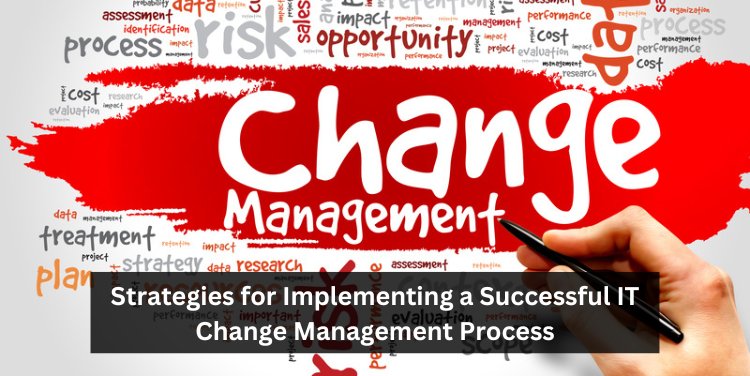Strategies for Implementing a Successful IT Change Management Process

In today's fast-paced business environment, effective IT change management is crucial for ensuring that technological changes are implemented smoothly, minimizing disruptions and maximizing benefits. A well-structured change management process helps organizations adapt to new technologies, improve efficiency, and maintain a competitive edge. This blog explores key strategies for implementing a successful IT change management process, ensuring that changes are managed effectively and with minimal risk.
Understanding IT Change Management
IT change management involves the systematic approach to transitioning individuals, teams, and organizations from a current state to a desired future state in the IT environment. It aims to control the lifecycle of all changes, facilitating beneficial changes with minimal disruption to IT services.
Key Strategies for Successful IT Change Management
1. Establish a Clear Change Management Policy
Define Objectives and Scope
A clear change management policy should outline the objectives, scope, and principles guiding the process. It should specify what constitutes a change, who can request changes, and the types of changes covered (e.g., standard, emergency, or major changes).
Communicate Policy to Stakeholders
Ensure that the change management policy is communicated effectively to all stakeholders. This includes IT staff, business units, and management. Clear communication helps in setting expectations and ensuring everyone understands their roles and responsibilities.
2. Form a Change Advisory Board (CAB)
Role of the CAB
The Change Advisory Board (CAB) is a group of stakeholders responsible for reviewing, evaluating, and approving change requests. The CAB ensures that changes are assessed for risk, impact, and resource requirements before implementation.
Diverse Representation
Include representatives from various departments within the CAB to ensure a comprehensive evaluation of changes. This diversity helps in assessing the broader impact of changes on different parts of the organization.
3. Implement a Robust Change Request System
Standardized Request Forms
Develop standardized change request forms that capture all necessary information about proposed changes. This should include details such as the reason for the change, potential risks, impact analysis, and rollback plans.
Centralized Tracking
Use a centralized system to track all change requests. This system should provide visibility into the status of each change, from submission to approval and implementation. It helps in maintaining an organized record and facilitates better communication.
4. Conduct Thorough Impact and Risk Assessments
Assess Impact on Business Operations
Evaluate the potential impact of proposed changes on business operations, users, and IT services. Consider factors such as downtime, resource allocation, and interdependencies with other systems.
Identify and Mitigate Risks
Identify potential risks associated with each change and develop mitigation strategies. This includes creating contingency plans and defining rollback procedures in case the change causes unexpected issues.
5. Develop a Comprehensive Change Plan
Detailed Implementation Plan
Create a detailed implementation plan for each change, outlining the steps required, responsible parties, and timelines. The plan should also include testing procedures to ensure the change does not negatively affect existing systems.
Communication Plan
Develop a communication plan to keep all stakeholders informed throughout the change process. This includes notifying affected users about scheduled changes, potential impacts, and expected outcomes.
6. Test Changes in a Controlled Environment
Use a Staging Environment
Test changes in a staging or test environment that mimics the production environment. This helps in identifying potential issues before the change is implemented in the live environment.
Pilot Testing
For significant changes, consider conducting a pilot test with a small group of users. This allows for real-world testing and provides feedback that can be used to refine the change before full deployment.
7. Implement Changes During Low-Impact Windows
Schedule Changes Strategically
Schedule changes during times of low business activity to minimize disruption. This could be after business hours, during weekends, or planned maintenance windows.
Notify Users in Advance
Provide advance notice to users about scheduled changes, including the expected duration and potential impact. Clear communication helps in managing user expectations and reducing frustration.
8. Monitor and Review Changes Post-Implementation
Continuous Monitoring
Monitor the performance and stability of systems after implementing changes. This helps in identifying any issues early and allows for prompt resolution.
Post-Implementation Review
Conduct a post-implementation review to assess the success of the change. Gather feedback from stakeholders, evaluate whether the objectives were met, and identify lessons learned for future changes.
Implementing a successful IT change management process is critical for managing technological changes effectively and minimizing disruptions. By establishing clear policies, forming a Change Advisory Board, implementing robust request systems, conducting thorough assessments, and maintaining continuous communication, organizations can ensure smooth transitions and sustained improvements. A strategic and well-coordinated approach to change management not only enhances operational efficiency but also strengthens the organization's ability to adapt and thrive in a rapidly evolving technological landscape.
What's Your Reaction?















